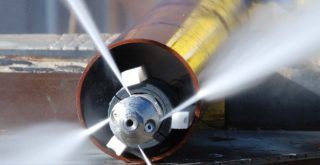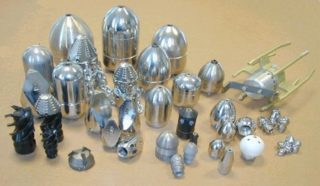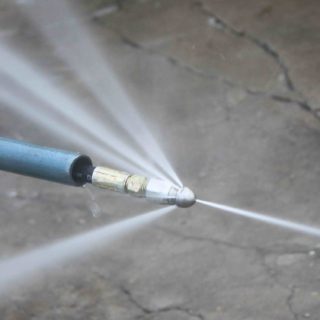Clogging of sewer pipes occurs quite often and everywhere: in everyday life and at work, in an apartment and a country house. Causes of blockages: negligence of the owners, who did not install protective gratings on the sinks and bathtubs drains, as a result, large parts of kitchen waste fall into the sink or toilet drain, until the inner walls of the pipes are fouled with fat. By types of blockages, they can be divided into mechanical ones, when a foreign object enters the pipe; operational - due to long-term operation, the pipes inside are overgrown with fat, hair, food waste, and mineral waste stick to it, when limescale and rust are formed. For these reasons, the inner diameter of the pipes decreases, resulting in frequent blockages.
Design and principle of operation
Water flows through the compressor from the tank into a high-pressure hose, at the end of which there is a nozzle with holes. The hole in the direction of travel breaks the blockages and flushes out, and the holes in the back of the nozzle move the entire structure forward according to the principle of jet thrust and at the same time clean the pipe walls. As a result, the pipes are cleaned along the entire length of the machine passage, and not in any specific place. There are hydraulic installations for domestic and industrial, the principle of operation is the same, the difference is only in the size and principles of connection.
Households are powered by an electric motor, but there are designs with a small internal combustion engine such as a motorcycle. Industrial installations are located on the basis of cars and are connected from the vehicle engine.
By dividing installations into industrial and domestic, it can be seen that they are used in different areas - domestic ones are used on small-diameter pipes to clean the sewage system in residential premises, in summer cottages and other household areas, and industrial ones to work on intra-quarter and city networks. Industrial plants are powerful and do not depend on the availability of electricity. The advantages of household installations are low noise and ease of transportation.
Operating procedure
Do not turn on the device before inserting the nozzle, otherwise you may be injured by high pressure water. The hose will move inside the pipe. You will feel when the tool reaches the blockage point (water will go away abruptly), after passing the blockage point, pull the hose back and make several forward movements in this place back and forth for better cleaning of the pipe. Then continue to release the hose forward until the end of the pipe or complete unwinding of the hose. Turn off the device and remove the hose from the sewer pipe. Pour plenty of water over the pipe.
Types of attachments
- punching holes that break through old, "petrified" blockages;
- rotating to remove sediments along the entire diameter of the pipe;
- bottom for cleaning sediments (sand, silt);
- cutting for crushing foreign objects and plant roots;
- rotary for cleaning fat deposits; universal, performing various functions.
Any nozzle has direct and reverse openings on its direct body, into which water is supplied under high pressure.
Advantages and disadvantages
Before other cleaning methods, the hydrodynamic method compares favorably with the fact that:
- cleans pipes along their entire length, and not only in the place of blockage, in contrast to cleaning with a plunger or cable;
- pipe walls are cleaned completely around the circumference and along the entire length, and not only at the point of blockage;
- despite the high pressure and work under pressure, water does not damage the pipe joints, as well as the pipes themselves;
- regardless of the location of the pipes in the horizontal and vertical planes, it cleans the sewage system up to 50 meters from the place where the nozzle is inserted;
- allows you to break pieces of ice by supplying hot water through a hose;
- owners of private houses in this way can also flush the storm sewer;
- planned cleaning triples the service life of sewer pipes;
- high speed of work, cleaning in an apartment will take 1 hour, in a private house 3-4 hours.
If you decide to work professionally on cleaning sewer pipes, then first you must definitely decide where you will mainly use the tool. Indoors, in garden areas, sewage pipes have a diameter of 50 to 100 mm, therefore a portable compact model, portable or on wheels, is suitable. The length of the hose on such models starts from 15 meters. To clean the main pipelines of the sewerage or stormwater systems, where the diameter of the pipes increases to 300 mm and more, a powerful installation on a car chassis is already needed. The autonomy of such installations allows them to be used in places where there is no electricity.
For work in summer cottages, small industrial organizations, you can purchase a car mini-wash "KARCHER ". The length of the cleaning hoses starts from 15 meters. The price of such a device is 16 thousand rubles and more. In addition to cleaning sewer pipelines, they can wash the facades of small buildings and structures, and use them for various domestic needs.
Powerful professional hydrodynamic cleaning units are produced on the basis of trucks and minibuses, powered by the engines of these machines. The diameter of the hose and nozzles is within 30-50 mm, the water pressure is 150-200 atmospheres. The price of such installations starts from 90 thousand rubles.












